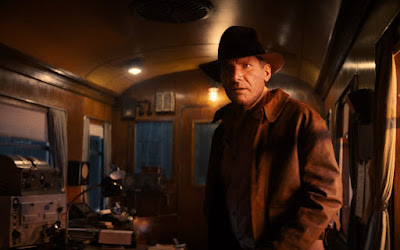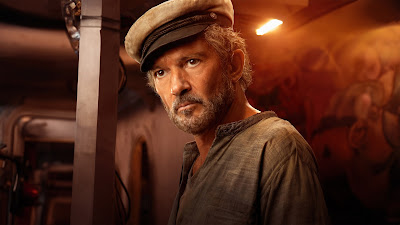It's taken 15 years to get here.
But now we really do have one last outing for Harrison Ford's Indiana Jones.
Ever since 'Raiders of the Lost Ark' rocketed to the top of the box office in 1981, Ford's beloved character has rarely been off our big or small screens.
Indiana Jones' four previous movie adventures always seem to be on our terrestrial TV channels.
In the early Nineties, there was also 'The Young Indiana Jones Chronicles' TV series on ABC which lasted just two seasons and a TV movie.
Indy's last big screen yarn, however, was 2008's ropey 'Indiana Jones and The Kingdom of The Crystal Skull'.
It was, however, a thundering disappointment to many fans despite making a tidy profit.
So you can understand why many in the film industry felt Hollywood's most famous archaeologist needed to go out on a high.
Now Mangold's film has arrived, does he?
'Indiana Jones and the Dial of Destiny' is most definitely an Indy film but not as we know it.
For starters, Steven Spielberg isn't in the director's chair.
That honour has fallen instead to James Mangold of 'Copland,' 'Walk The Line' and 'Logan' fame.
Then, there's the fact that so much time has passed.
Harrison Ford is - how should we put this delicately? - in his bus pass years.
He still looks pretty good for 80 but he was still 78 during filming.
Nostalgia is all well and good but in an action franchise like this, how do he and James Mangold compensate for the ravages of time?
Ford's director partially tries to address this by deploying digital de-aging technology for the first act of the film before setting the rest of the action 25 years later.
That sounds like a solid plan but remember Martin Scorsese's 'The Irishman' showed digital de-aging isn't quite the magic wand you'd hope even in a well crafted film.
A seventysomething actor may look artificially younger onscreen but the way he or she moves can still undermine the audience's belief that they are portraying thirty or fortysomething characters.
Undeterred, Mangold's two and a half hour Indiana Jones instalment embraces the technology and begins in Nuremburg in 1944.
Our first glimpse of our digitally de-aged hero is while he is in the clutches of the Nazis as the Allies besiege them and liberate Western Europe.
Thomas Kretschmann's nasty Colonel Weber has rounded up all the artefacts the Nazis have plundered for Hitler in his reach and packs them on a train.
Indy and Toby Jones' Oxford archaeology professor Basil Shaw have ventured behind enemy lines to recover from the consignment the Lance of Longinus, which is purported to have pierced the side of Jesus Christ on the cross.
Before his platoon flees, Weber orders some of his soldiers to hang Indy.
He also sends his troops out to find Indy's accomplice, eventually capturing Basil.
The lance, however, turns out to be a fake.
However an astrophysicist accompanying Weber, Mads Mikkelsen's Jurgen Voller realises half of the Antikythera, Archimedes famous dial is on board the train and that it could help turn back time to the Nazis' advantage if he could just locate the rest of it.
Weber is unimpressed.
With a mixture of good fortune and ingenuity, Indy escapes his Nazi captors and boards the fleeing steam train, discovering the lance isn't real but Archimedes' dial is there.
Rescuing Basil, he battles Weber, Voller and countless Nazis to swipe half of the Antikythera and while the two of them make off with the treasure, Voller falls from the train while Allied warplanes take out the enemy.
Mangold propels us into 1969 as New York welcomes home the NASA Moon landing crew.
Indy is in his boxers, his hair is grey and his body is a bit more saggy and wrinkly as he wakes up from a drunken stupor to the sound of The Beatles' 'The Magical Mystery Tour' blaring from a neighbour's flat.
We soon learn his true love, Karen Allen's Marion Ravenswood has left him and initiated divorce proceedings following the death of their son Mutt in Vietnam.
Indy is understandably grouchy as he makes his way to Hunter College in Manhattan where he is about to retire from academia.
Delivering one more tired lecture to his bored students, he peps up when Phoebe Waller-Bridge's Helena Shaw answers some of his questions from the back of the theatre.
However he doesn't realise who she is: Basil's daughter and his own goddaughter.
Going to a saloon after being handed a clock to mark his retirement, he is followed by Helena who reveals who she is and explains she is keen to research the dial which her father became obsessed with.
She cajoles Indy into showing her the half of the dial which he has kept hidden in Hunter College after Basil insisted on him taking it away from Blighty.
The problem is Voller is also in town having worked on the NASA space program and while he is basking in the glory of the Moon landing, he is still harbouring designs on locating the dial and reassembling it.
Aware that Helena has plans for it too, he has her followed to Hunter College by Shaunette Renee Wilson's CIA agent and Foxy Brown lookalike, Mason.
Voller also unleashes his 'shoot first, ask no questions' goons, Boyd Holbrook's Klabber and Oliver Richter's grunting muscleman Hauke.
In the inevitable confrontation that follows, Indy escapes with his life but Helena makes off for Morocco with the dial after a dramatic pursuit through the streets of Manhattan and its subway system.
Indy is disappointed to learn Helena's interest is not academic but is more motivated by money.
With the help of his old chum John Rhys Davies' Sallah, he heads to North Africa to recover the dial but with Voller and his goons also on his tail.
This sparks another globe trotting adventure where Indy again explores caves, encounters creepy crawlies, dabbles in Ancient magic and has to eventually outwit the Nazis.
With a script by the acclaimed English playwright Jez Butterworth, his brother John Henry Butterworth, Mangold and David Koepp, the first thing you notice about 'Indiana Jones and The Dial of Destiny' is how it adheres to the basic narrative formula of the series.
After the supposedly thrilling action packed preamble, the writers lay the seeds of the adventure by explaining the significance of the artefact everyone covers.
They trek across the world to decipher clues and uncover its location.
Eventually, there's a grand finale where our hero and villains realise the true power of the treasure they seek.
However it is with considerable regret that I have to write this but it just doesn't work.
The execution of the plot is too laboured.
At a running time of 154 minutes, 'Indiana Jones and The Dial of Destiny'bis too baggy and too long drawn out to catch your imagination.
Like a lot of studio films these days, it's a bloated film that relies more on spectacle instead of a tight, well executed script.
Maybe studio films are clocking in longer running times these days as an over compensation for the rise of streaming shows.
However studios really ought to think again about bucking this trend.
Sometimes less is more effective.
Just look through the Indy back catalogue.
'Raiders of the Lost Ark' was a 115 minute film.
Its sequel 'Indiana Jones and The Temple of Doom' took three minutes longer, while 'Indiana Jones and The Last Crusade' was 128 minutes long.
However it isn't just the two and a half hour running time that's the problem.
The opening preamble feels a bit perfunctory, failing to genuinely thrill.
It's as if Mangold and his screenwriters are going through the motions of trying to tick off all the elements of a typical Indiana Jones adventure.
The digital de-aging of Ford is also a distraction.
While it is certainly more impressive than Robert de Niro or Joe Pesci in 'The Irishman,' it's still not quite there.
So while the face is definitely like the younger Ford, you still find yourself becoming weirdly fixated and distracted by his unnatural looking hair.
When the plot goes 25 years forward, it plods on with Waller-Bridge and Ford cracking wiseass gags and Mikkelsen vamping it up as the villain.
Indy fans will be willing for the film to deliver what 'Indiana Jones and the Kingdom of the Crystal Skull' couldn't.
But while it a vast improvement on that film, it still significantly lags behind the first three.
The action sequences are just too bloated and leggy.
The high speed pursuits at times get - dare I say it? - a bit boring.
And it just isn't as funny as it ought to be.
The one moment of bliss that occurs is the climactic action sequence which involves time travel.
However nods to the James Bond and 'Mission Impossible' franchises only illustrate how they have moved on and Indiana Jones' has moved backwards.
This is a shame because Ford puts his heart and soul into it and delivers a typically droll, charismatic performance.
Mikkelsen proves a worthy villain.
However Waller-Bridge, Holbrook and Renee Wilson are only just okay.
And while it is nice to see Rhys Davies back as Sallah, Ethann Isidore's Moroccan pickpocket Teddy Kumar is a bit irritating and is certainly no Short Round.
Antonio Banderas is incredibly hammy too as an old Spanish sea dog friend of Indy's called Renaldo.
For the brief time he is onscreen, Toby Jones is a welcome presence.
Watching 'Indiana Jones and the Dail of Destiny' is a disappointing experience.
The sharpness of the writing in previous instalments is missing and the film drags as a result.
It may look like an Indy film but you can't help feeling that four screenwriters being involved is a huge indication of the struggle to get this to the big screen.
'Raiders,' which is still the best of the five films had just one writer - Lawrence Kasdan.
'The Temple of Doom' had two - Willard Huyck and Gloria Katz - and 'The Last Crusade' had Jeffrey Boam working from a story by George Lucas and Menno Meyjes.
The fact that this had four probably tells you enough.
Sometimes you can flog a good idea to death.
And this appears to confirm the franchise died 15 years ago.
May it rest in peace.
('Indiana Jones and The Dial of Destiny' opened in UK and Irish cinemas on June 28, 2023)



















Comments
Post a Comment